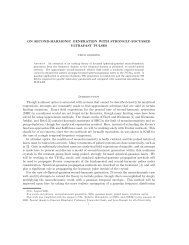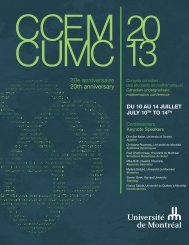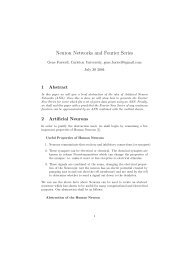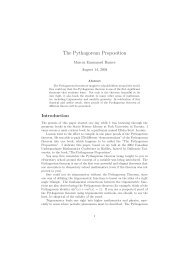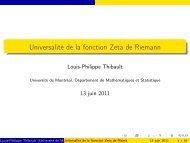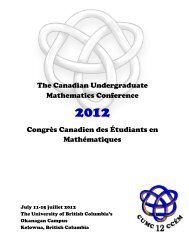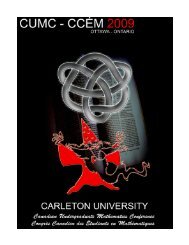booklet - CUMC - Canadian Mathematical Society
booklet - CUMC - Canadian Mathematical Society
booklet - CUMC - Canadian Mathematical Society
Create successful ePaper yourself
Turn your PDF publications into a flip-book with our unique Google optimized e-Paper software.
INTRODUCTION TO STATISTICS: CLASSICAL AND BAYESIANWILLIAM RUTHThe Bayesian perspective is an increasingly popular paradigm within modern probabilityand statistics. This presentation will begin with some elementary probabilitytheory from both the Classical and Bayesian perspectives. Some famous problems instatistics will be introduced and solved using both points of view. Techniques for implementingthese solutions with actual problems will be examined with an emphasison Bayesian methods.A SCHUR-LIKE BASIS IN NSYM AND A RULE OF RIGHT-MULTIPLYING A RIBBON TOTHIS BASISYAN XUWe define a Schur-like basis of NSym by a Pieri’s rule, call Shin-basis. There is a nicemultiplication structure for right-multiplying Ribbon-basis to Shin-basis. Furthermore,based on this multiplication rule, more Schur-like properties can be deduced, such asthe Pieri’s rule of right multiplying by the elementary basis of NSym.COMBINATORIAL ABSTRACTIONS OF THE POLYNOMIAL HIRSCH CONJECTUREYUE RU SUNThe Hirsch conjecture is a conjecture in polyhedral combinatorics stating that thediameter of a polytope is upper bounded by the number of its facets minus its dimension.This conjecture was proposed by Warren M. Hirsch in 1957 and has been recentlydisproved by Francisco Santos; however, whether a polynomial upper bound for thediameter exists is still unknown up to this date; this question is commonly referred toas the polynomial Hirsch conjecture.In this talk, we will briefly look at the history and some known results about thisdiameter problem, then we will concentrate on a combinatorial abstraction of polytopesand prove two best known upper bounds on their diameter using this abstraction.Required Background: basic knowledge of polyhedra, combinatorics and setsA VERY BRIEF INTRODUCTION TO DECONVOLUTION PROBLEMSYVAN LEIt is known that the probability density function of a sum of two independent randomvariables is given by the convolution of their respective densities. Thus, the classof deconvolution problems deal with estimating the density of a random variable ofinterest, given data that has been tainted by a noise variable. This talk presents a verybrief overview of what typical deconvolution problems may be, as well as the twogeneral approaches to solving them - the kernel density estimation method, and thewavelet transform method.49



